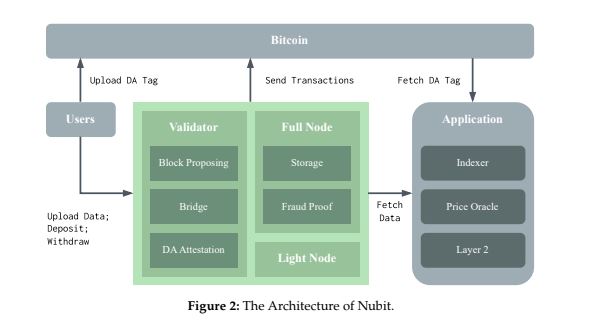What is Nubit? Nubit is a data storage layer for the Bitcoin network with the ambition of reducing data storage costs compared to Bitcoin’s current approach, while maintaining a high level of security. Nubit is currently receiving a lot of attention from the community, so where did the project have such initial success? Everyone, let’s find out in the article below.
Nubit Overview
What is Nubit?
Nubit is an initiative of Riema Labs, which is an efficient and low-cost Data Availability layer for the Bitcoin ecosystem. This project develops in the context of increased demand for Inscriptions on Bitcoin, leading to large amounts of data being stored at high costs.
To put it simply, instead of directly writing all the data to the Bitcoin Blockchain, users can upload images or other data to Nubit and only write a 16-byte DA Tag and a special identifier 2 -bytes on Bitcoin. This method significantly reduces network costs and load on the Bitcoin network.
Nubit is designed to support many different data types, including:
- Inscriptions: Enables the storage of digital works such as NFTs and BRC-20 JSON documents on the Blockchain.
- Price Feeds: Integrate critical, real-time financial data for Bitcoin-based DeFi applications.
- Rollup Data: Supports Layer 2 scale by allowing rollup transaction data to be stored and managed.
Structure of Nubit

Nubit includes several main components:
- Validator: Is an important part of Nubit, consisting of three sub-components: Block Proposal, DA Attestation, and Bridge. Validator is responsible for the majority of Nubit’s operations, including processing uploaded data, managing bridges, and recording roots on the Bitcoin Blockchain.
- Bridge: Manage users depositing and withdrawing BTC to pay fees. Deposits are easy, but withdrawals face security problems. To solve this, Nubit uses an election-based multi-signature wallet system.
- Full Nodes: Full Nodes play an important role in maintaining data integrity on the network. They are responsible for storing all data and sending block information, including headers and proof of fraud, to Light Nodes.
- Light Node: Allows users to connect directly to the network without the need for a central RPC provider. Their main role is to monitor new block headers and perform Data Availability Sampling (DAS) on them.
Nubit also relies on a number of assumptions about security, including the honest and efficient Validator majority of DAS. The 1-to-N Full Node security model ensures data security as long as an honest Full Node exists.
Development Roadmap
Nubit’s development roadmap has some notable points as follows:
- Post Prototype: Immediately after the Prototype Stage, Nubit plans to launch the Ordinals DA protocol, an important step in establishing a strong position in the market.
- Stable DA: During this phase, while maintaining a centralized approach in block proposal and bridge components, Nubit will begin integrating centralized DA Attestation and deploying decentralized full nodes.
- PoS Validator: The focus shifts to decentralizing the block proposal process using Proof of Stake consensus.
- Trust Minimization: This is the final stage, where Nubit fully embraces decentralization in all components, including block proposals, bridges, DA Attestation, and both full nodes and light nodes.
Investor
Update…
Core Team
Update…
Tokenomics
Update…
Exchanges
Update…
Project Information Channel
Summary
Nubit continues to be a project participating in the Bitcoin ecosystem movement with a solution for data storage and availability. Hopefully through this article everyone can understand more about what Nubit is?


